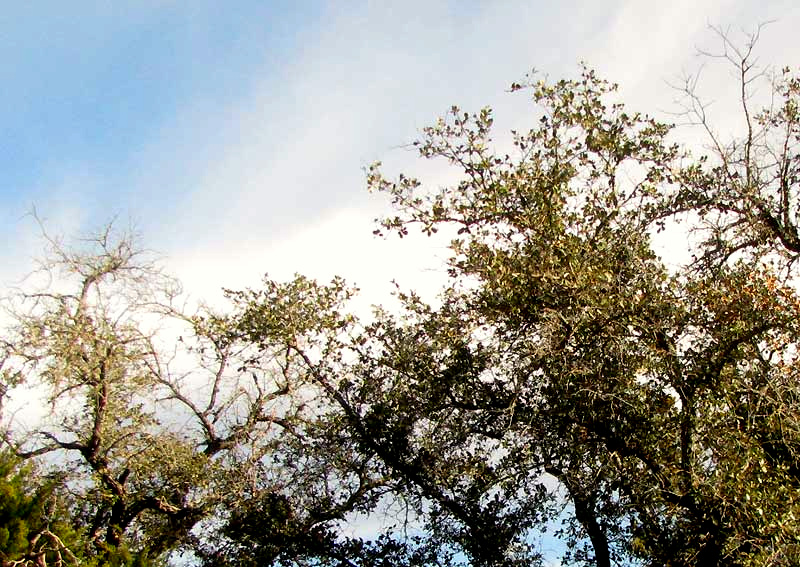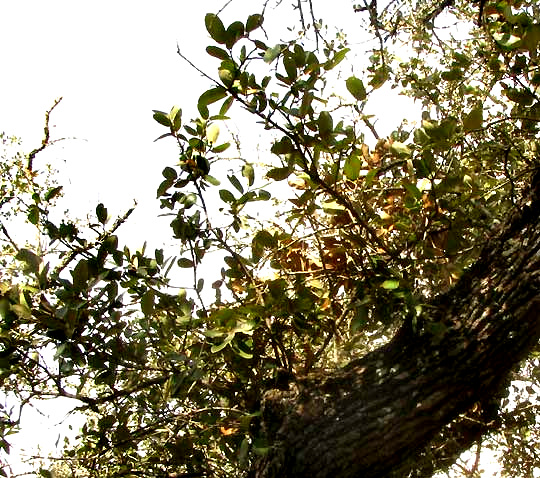Excerpts from Jim Conrad's
Naturalist Newsletter
from the January 26, 2014 Newsletter issued from the Frio Canyon Nature Education Center in the valley of the Dry Frio River in northern Uvalde County, southwestern Texas, on the southern border of the Edwards Plateau; elevation ~1750m (~5750 ft); N29.62°, W99.86°; USA
OAK DECLINE
In the Texas Hill Country there's Oak Wilt and Oak Decline, two different things, and both are devastating our oaks. In our more arid southwestern corner of the region, we have Oak Decline but, so far, I don't see Oak Wilt. Oak Wilt is bad just to our east, for example in San Antonio, where it's killing many old street and park trees.
In our hilly area the forest is dominated by Ashe Junipers and Texas Live Oaks, with just a handful of other species sprinkled among them, especially Texas Red Oaks, which also are suffering from Oak Decline. Oaks are so dominant in our forests that if they disappear the very nature of our woodland ecology will be altered catastrophically.
The next picture shows what Oak Decline looks like on trees beside Juniper House:

Those are the tops of Texas Liveoaks, Quercus fusiformis, which are about 20 feet tall (6m). At this season healthy trees still bear their leaves; the leaves will fall in April as new ones emerge. The thing to notice is that major branches in the trees' crowns are leafless -- dead, in fact. They were dead this summer, and as time passes more limbs die in the trees' upper part. That's the main symptom of Oak Decline: Some branches dying while others don't, but the trend is toward all of them dying. Curiously, many oaks succumbing to Oak Decline also show what's seen below:

Those are new sprouts developing on the lower trunk of one of the trees shown above. As larger branches die above, new sprouts issue from the trunk close to the ground. Eventually even these will die, however. The amount of time taken for a tree to die completely depends on how much stress the tree is under, especially whether it's getting enough rain.
There's a disease organism involved, a fungus called Acremonium diospyri. However, this fungus is described as a "weak vascular pathogen," which means that it not very aggressively enters a tree's vascular system and clogs it so that water and nutrients can't get to where they're needed. The fungus becomes a serious problem only on trees already stressed, as our trees are by the drought experienced here during recent years. The disease caused by Acremonium diospyri is like measles among humans: Among healthy individuals it might be bothersome, but not deadly. Besides our Texas Live Oaks, other trees affected by Acremonium diospyri are Texas Red Oak, Post Oak, Water Oak, Willow Oak, Sycamore, Persimmon, Winged Elm, Hackberry, American Elm and Western Soapberry.
Every liveoak on our hill shows signs of Oak Decline, but those growing along the Dry Frio River are in good shape, apparently because they're getting adequate water. There's some indication that the fungus can be spread between trees by bark beetles. Confirming the presence of the fungus is hard, even for experts, so I'm only guessing that it's contributing to Oak Decline here.
Texas A&M University's Plant Disease Handbook suggests these steps for reducing die-back of liveoaks from Oak Decline: 1) Identify the problem; 2) Reduce stress on the trees; 3) Provide plenty of fertilizer and water; 4) Remove dead limbs on tree; 5) Don't import wood from areas with Oak Decline, and; 6)Plant trees other than those vulnerable to the Oak Decline fungus.
In our area of severe ongoing drought, on one hill among many with thousands of declining liveoaks, all we can do is to watch the decline take place, and hope for rain.